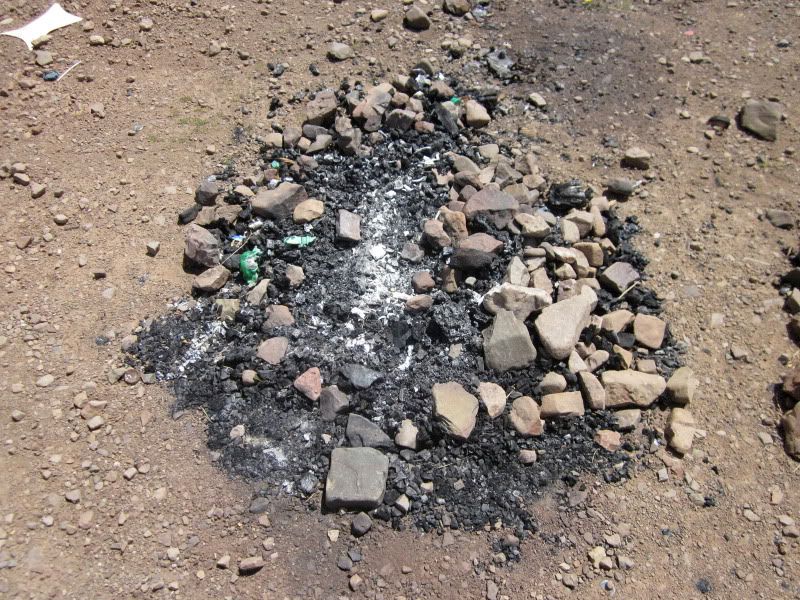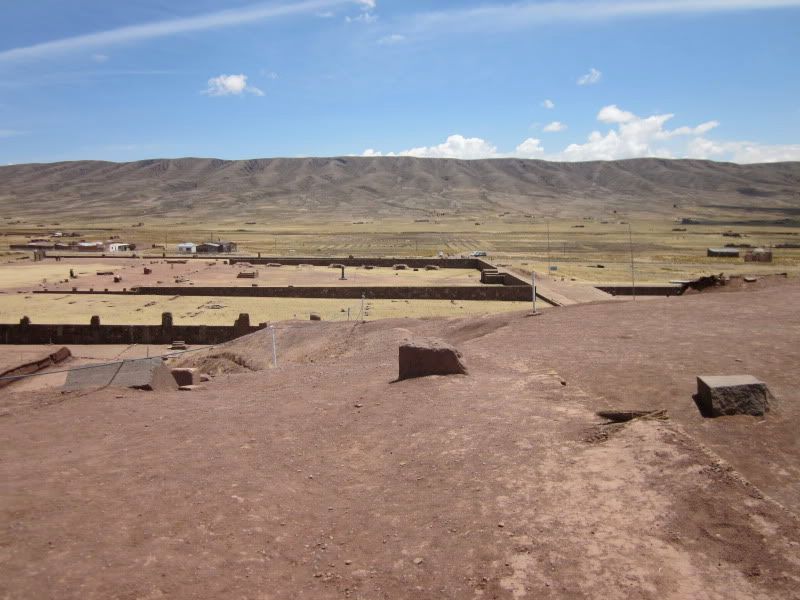I'm splitting this into two diaries. The first will cover a tour of the area of Tiahuanaco with an explanation of everything and how it relates to past and present Andean cosmology. The second will be more focused on agriculture and will follow what our group did after lunch, when we went into the museum to learn more about Tiahuanaco culture.
I took pictures as we drove of the adobe homes we passed and the haystacks next to them. We saw tons of cows (mostly Holstein) and sheep, but not a single camelid. As it turns out, Lake Titicaca provides warmth and humidity to the northern part of Bolivia's altiplano (high plain), allowing both sheep and cattle to thrive, along with crops like quinoa, potatoes, barley, fava beans, and oats. After grain is harvested, the leftover parts of the plant are gathered as straw and fed to animals.
We heard again and again that the winter came late this year, with the first snow at the very end of winter instead of the beginning, and only "one and a half" snows (one heavy and one light) instead of the usual five. Normally the rains would have started by early October, but they hadn't yet. Thus, the land we passed was bone dry, covered in what appeared to be dead grasses, and the crops weren't growing yet either.

The altiplano

Another look at the altiplano

An altiplano home with a haystack inside its yard

A home on the altiplano

Another haystack

An indigenous woman (cholita) selling a favorite Andean food by the side of the road near a toll booth. The food is made of dried peaches boiled in water with cinnamon sticks and sugar.
Lloco Lloco
We began with a stop in a place called Lloco lloco, on the top of a hill. In the distance, we could see the city of El Alto (near La Paz). In the other direction, we could see Lake Titicaca. Because the lowlands of Bolivia are in the midst of the "burning season," the air in the altiplano was full of smoke, making it difficult to see the snow covered Andes.
Directly in front of us, we saw various small fields that were used for agriculture. Prior to the 1952 Revolution, much of the land was divided into haciendas. The revolution brought with it land reforms, giving the peasants their own land. With each generation, these plots get split between siblings, making them often very small today. These small plots are referred to as "minifundios." The way food is grown today is very different from the sophisticated system developed in the Tiahuanako era.

The view from Lloco lloco
In the indigenous tradition, the tops of mountains are sacred - including Lloco lloco. Near where we stood, we saw the burnt remains where several people had made offerings to Pachamama (Mother Earth). Distinguishable among the remains was an orange peel and a soda bottle. Apparently, Pachamama is a bit of a bad girl, because I learned later that it's typical for offerings to include booze, coca, and cigarettes.

An offering

Another offering
Tiahuanaco
The civilization of Tiahuanaco is divided into five different periods. From 1500 BC to 45 AD (Epochs I and II), the civilization was quite small. Epoch III (45 AD to 700 AD) is considered "urban," when the site grew quite a bit. The last two Epochs (IV and V) are called Expansive, when Tiahuanaco culture influenced a large area extending from Peru to northern Argentina (700-1200).
At first, it was thought that Tiahuanaco culture expanded militarily, but now that does not seem to be the case. Instead, it seems that their religion, pottery, and agricultural system spread throughout the area, and perhaps their control was religious and not based on military might. It is also thought that Tiahuanaco itself is not what we think of as a permanently settled city. It was more of a place where people came for pilgrimages. At the time, it would have been incredibly impressive to anyone who saw it. It's also important to keep in mind that Tiahuanaco evolved and changed over time, and all of the elements of the site that we see today were not present throughout the civilization's entire history.

A model of the entire city of Tiahuanaco. In the front, you'll see the pyramid. Behind it to the right is the subterranean temple. Directly to the left of that is the other temple we visited.
The Akapana Pyramid
Our tour began with a climb up a pyramid and a most interesting discussion. In the Aymara tradition, the earth is divided into three realms: alakhpacha (heavens/sky); akapacha (the present, on earth); mankapacha (the world underground, belonging to gods that give power to animals and plants). "Pacha" means both space and time. The Aymara, an empire that arose after Tiahuanaco and a culture that thrives today in Bolivia, may or may not be the descendants of the Tiahuanaco civilization. Still, it seems that the idea of these three realms was quite present in Tiahuanaco spirituality.
With this in mind, one can look at the pyramid and see how it includes all three elements, with its entrance on the level ground of the earth, then climbing high towards the sky, and then at the top, there is a dug out area that is below ground to symbolize mankapacha. Unfortunately, we don't know exactly what the mankapacha area truly looked like, since it has been expanded by someone who was looking for riches buried in the pyramid.

The base of the pyramid

A view of Tiahuanaco from atop the pyramid

A stone on the top of the pyramid. The shape carved in here is a commonly used one in Tiahuanaco

The subterranean area on the top of the pyramid

Some remains of houses on the pyramid, probably homes of high priests

Many of the stones of the pyramid have been removed, making it look like a funny shaped hill, but on this side, you can see where some of the stones are still there.
Subterranean Temple
Next, we visited the Subterranean Temple, which basically looked like a big pit from a distance. Inside, the walls were lined with a number of faces, many of which were different from one another. In the center was a big pillar with a face carved into it.

One of the faces in the Subterranean temple

More faces in the Subterranean temple

A pillar in the Subterranean temple with a face.
Another Temple
There's another large temple at Tiahuanaco, one that is above ground instead of below ground, and that's where we went next. I don't have a picture of the entire temple because it is huge. I do, however, have some nice pictures of the drainage system for the temple. This would have been useful during the rainy season, but it might have also been used for "offerings" to Pachamama like urine or vomit. It's reasonably likely that some of the religious ceremonies or festivals took place while all of the participants were drunk off their asses on chicha (an alcoholic beverage).

The side of the temple

The side of the temple, showing its drainage system

The side of the temple, with its drainage system
As we walked around the side of the temple, we saw one of the pillars was carved in the shape of a woman with the tail of a fish. In Andean spirituality, there is an idea similar to Yin and Yang. The yang equivalent is urko, representing male, light, strength, the heavens, and the yin side is uma, representing female, dark, nurturing, and underground. Thus, Tiahuanaco culture often linked women with marine organisms like fish, since they live below the surface of the earth.

A pillar of the temple, which is shaped like a woman with the tail of a fish
Then we walked up to the top of the pyramid, where we saw a carved pillar known as the Ponce Monolith. You might be able to see that the figure is holding a knife in his right hand, and he's holding it with his palm facing outward. This means that he is going to make a sacrifice to the gods. In his other hand, he is holding a sacred glass. The Spanish, of course, tried to exorcise this monolith, so if you look on the side of it, you will see a cross carved in.

The front of the monolith. Couldn't get a good picture with the sun.

The side of the monolith, where, if this were a better picture, you'd see a cross carved in by the Spanish.
Last but not least, we visited the Gate of the Sun. This is enormous, and that's more or less most of what I have to say about it. It might sound like I'm being glib, but considering that this is an enormous, heavy hunk of rock that was moved here and carved by a people that did not have wheels or horses, its size is quite significant. Its location now is not necessarily the original location. Carved into it is the Sun God in the top center.

The Gate of the Sun
One last important point to make is that during the many centuries of Tiahuanaco culture, they were tearing down and building new temples and structures every so often. As such, often temples are built by mismatched rocks that were carved to be part of other temples and then recycled and fit together as part of a new temple.
No comments:
Post a Comment